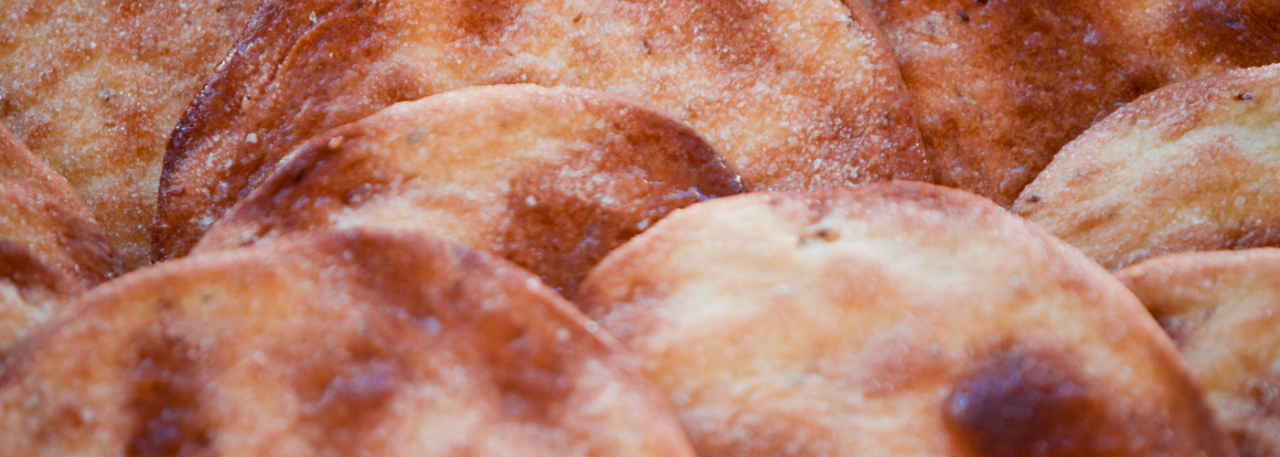.png.transform/rendition-xs/image_image%20(1).png)
Tortas de Aceite de Castilleja de la Cuesta TSG
Confectionery product containing 27.7% Spanish extra virgin olive oil. This, together with the fact that they are made entirely by hand, gives the Tortas their most highly prized qualities: they are light, with a smooth puff pastry and the unmistakable flavor and aroma of olive oil.
Tasting notes
Color: uneven toasted brown, with some darker areas where the pastry is thinner.
Smell: a characteristic, mild aroma of anise and olive oil.
Flavor: sweet, distinctive.
Texture: firm, with no softening, a flaky texture.
Other notes
Physical and chemical properties:
Values per 100g of product:
Nutritional Value: 495 Kcal/100g (tolerance ± 10)
Proteins (N × 6.25): 6.5 Kcal/100g (tolerance ± 1)
Carbohydrates: 70g/100g (tolerance ± 5)
Fats: 22g/100g (tolerance ± 2)
Saturated: 14 %
Unsaturated: 85 %
Monounsaturated: 75 %
Polyunsaturated: 9 %
Cholesterol: 0
Moisture content: < 6%
Ash: < 1.5%.
Production / Processing method
Firstly, all the liquid ingredients, extra virgin olive oil, water and inverted sugar, are added to the flour base and everything is mixed together. Once they are well blended, the remaining ingredients are added and the dough is kneaded until the required consistency is achieved. The final temperature of the dough should be between 25ºC and 28ºC. If the temperature is higher, the dough will ferment in the hopper of the dividing machine and if it is lower fermentation will not take place. In both cases, the product would not have the desired appearance. To ensure the final temperature is constant, the temperature of the water added to the dough is varied by adding flakes of ice or hot water. In these cases the kneading time will also vary. The temperature may also be controlled by using food standard refrigerating gases.
Making the Torta by hand:
Once the kneading process is complete, the dough is split into portions. This is done using a machine that divides the dough into pieces of equal weight and the Torta is then shaped by hand. This process is done in the following way:
1) The ball of dough is picked up in one hand and then placed in the palm of the other hand.
2) With the fingers of the hand holding the dough held together, the outer edge of the other hand is placed in the middle of the ball and pressed down lightly, first moving towards the wrist and then towards the fingertips, so that the dough is spread out over the entire hand.
3) Each person has a container filled with white sugar next to them. They lightly smack the palm of the hand with the dough on the surface of the sugar and the Torta is thus covered with a fine layer of sugar.
4) To place the Torta on the baking line, they place their hand on the conveyor belt with the palm facing upwards and held a few centimetres above the belt. The part stuck to the little finger is released using the fingers of the other hand and placed on the belt, and at the same time the fingers of the hand holding the Torta are splayed open, giving it a round shape. The hand is then rotated until the palm is facing the baking conveyor belt, and at the same time the operator moves their hand away leaving the Torta on the belt with the sugar coating facing upwards.
This process of spreading the dough is what gives the Torta de Aceite its distinctive appearance, with a more or less rounded shape and a variable thickness of only a few millimeters. The nature of the dough, with its high fat content (olive oil in this case), makes the handmaking process a key factor of production, as any other process would squeeze out the oil, resulting in a product with very different characteristics.
Baking:
The product consists of a disc measuring around 13cm in diameter and a few millimeters thick. This shape, with its large area of exposed surface and lack of bulk, means that baking time is only a few minutes. When it is removed from the oven, the relative moisture content of the Torta de Aceite should be less than 6%. The resulting product is a rounded Torta (or pastry) with an irregular thickness of very few millimeters, tending to be slightly thicker around the edges. The color is toasted brown, with some darker areas where the pastry is thinner. The texture should be cripsy, firm and without softening, and it should have a pleasant smell of anise and olive oil.
Cooling and packaging the product:
After baking, the product is allowed to cool before being packaged. Because it is not very thick and has a large suface area, the product cools to a suitable temperature for packaging within minutes. Packaging is done in two stages:
- Individual packaging: In this process, each Torta is individually wrapped in waxed paper. To do this, the Torta is placed on the paper and the upper and lower sections are folder over it; next the right and left sections are folded over twice to make a pointed shape, which is then folded under the Torta.
- Packs of Tortas: Each group of five or six Tortas individually wrapped in waxed paper are placed on a tray to protect them from any knocks they may receive in transit. They are then packaged in heat-sealed polypropylene bags that fit tightly around the tray.
Regulatory Council
A.P.E.C.O.P.A.S.
Avenida Recaredo, 20, módulo 5
41003 Sevilla (Andalucía)
Tel.: + 34 954 576 427
info@apecopas.es
grupo@inesrosales.com
www.apecopas.es
Sources:
- Spanish Ministry of Agriculture
- APECOPAS
It is a disc measuring around 13cm in diameter and a few millimeters thick with a pleasant smell of anise and olive oil.


Sevilla (Andalusia)
